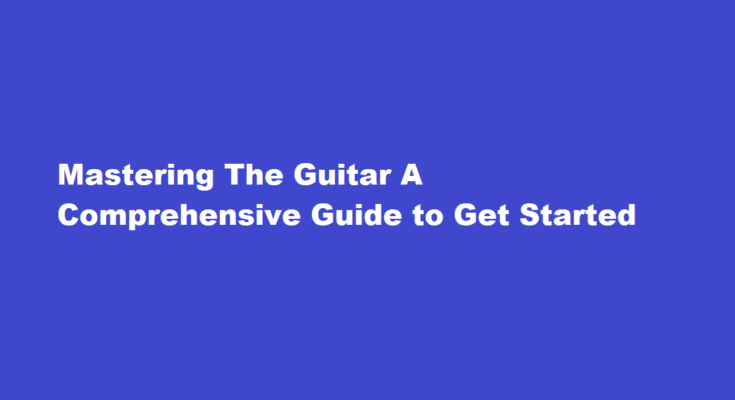Introduction
Playing the guitar is a rewarding and fulfilling hobby that allows you to express your creativity and connect with music on a deeper level. Whether you’re a complete beginner or someone looking to refine their skills, this comprehensive guide will provide you with the necessary steps and techniques to embark on your guitar journey. By following these essential tips and practicing consistently, you’ll be strumming your favorite tunes in no time.
Choosing the Right Guitar
Before diving into the world of guitar playing, it’s important to select the right instrument for you. Acoustic or electric? Nylon or steel strings? Consider your musical preferences, budget, and comfort. Acoustic guitars offer a warm, natural sound, while electric guitars provide versatility and amplification options. Ensure that your chosen guitar feels comfortable in your hands and suits your playing style.
Understanding Guitar Anatomy
To become proficient in playing the guitar, it’s crucial to understand its basic components. Familiarize yourself with the guitar’s body, neck, frets, and strings. Learn the names of the different parts, such as the headstock, tuning pegs, fretboard, and bridge. Understanding the anatomy of the guitar will help you follow instructional materials and communicate with fellow guitarists more effectively.
Tuning Your Guitar
Properly tuning your guitar is essential for producing accurate and pleasant sounds. Invest in a reliable tuner or use a free online tuner application. The standard tuning for most guitars is EADGBE, from the thickest string (low E) to the thinnest (high E). Familiarize yourself with tuning techniques such as using a tuning fork, piano, or relative tuning. Regular tuning ensures your guitar sounds its best and allows you to play along with other musicians.
Mastering Basic Chords
Chords are the building blocks of guitar playing. Start with the foundational open chords such as C, D, G, A, and E. Practice each chord individually and then gradually transition between them smoothly. Pay attention to finger placement, posture, and strumming techniques. Utilize online resources, chord charts, and instructional videos to assist you in mastering these essential chord shapes. With consistent practice, you’ll develop muscle memory and the ability to switch chords effortlessly.
Learning Strumming Patterns
Strumming patterns add rhythm and texture to your playing. Begin by practicing simple downstrokes and upstrokes in time with a metronome. Gradually progress to more complex patterns, incorporating accents, palm muting, and strumming variations. Experiment with different rhythms and tempos to expand your musical repertoire. Consistent practice and attention to dynamics will allow you to create engaging and captivating performances.
Basic Music Theory
While not essential, having a basic understanding of music theory can greatly enhance your guitar playing skills. Familiarize yourself with concepts like scales, intervals, and chord progressions. Learn to read guitar tabs and sheet music, as they serve as valuable resources for learning songs. Additionally, understanding the relationship between chords and scales will enable you to improvise and compose your own music.
FREQUENTLY ASKED QUESTIONS
Is it easy to learn to play guitar?
Guitar is hard to learn in the beginning, but gets easier the longer you stick with it. The more you practice, the easier guitar will feel to play. This is why most people who quit guitar do so in the very beginning.
Can I learn guitar alone?
The good news is, you can absolutely teach yourself guitar! It may have been hard to learn on your own time 20 years ago, but now great information is everywhere. The power of the internet has created an awesome database of resources for those who really want to learn.
Conclusion
Learning to play the guitar requires dedication, patience, and consistent practice. By choosing the right guitar, understanding its anatomy, tuning correctly, mastering basic chords, learning strumming patterns, and grasping basic music theory, you’ll be well on your way to becoming a skilled guitarist. Embrace the journey, seek out inspiration from other musicians, and remember that progress comes with time and effort. With each strum, you’ll unlock the joy of creating beautiful music and embark on a lifelong musical adventure.
Read Also : Mastering The Art of Using “When” with a Subject



